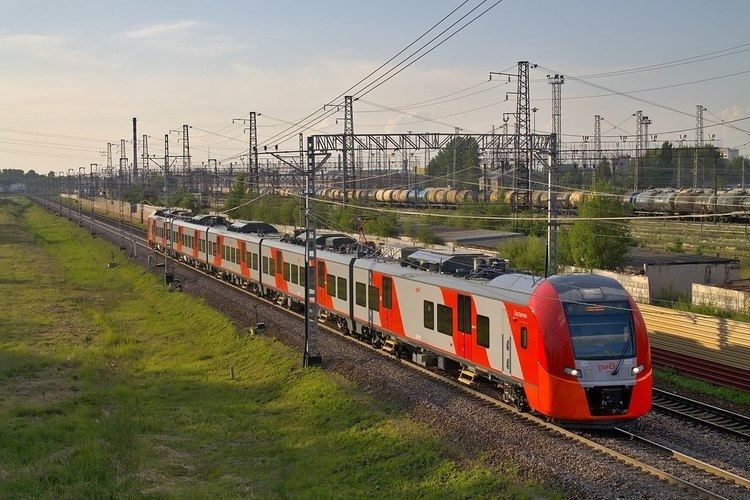In service 2013– | Capacity 453 | |
 | ||
Formation 5 cars (train set);10 cars (multiple working) | ||
The Lastochka (Russian: Ласточка, 'Swallow') is a Russian high speed electric express train, based on Siemens Desiro design.
Contents
Main information
In 2009, Russian Railways ordered 20 Siemens electric trains, for a version adapted to the conditions of Russia. The new trains were planned to be used in Sochi for suburban passenger traffic during the Winter Olympics 2014, and then to be partially transferred to other lines for non-stop service routes, having sections with alternating and direct current. Previously, Siemens had already produced dual-system Sapsan trains (Velaro RUS) for Russian Railways. The design of the new trains was to be based on the five-car Siemens Desiro ML electric train. On 29 December 2009, Russian Railways signed a contract with the German company Siemens for the supply of 54 Siemens Desiro RUS electric trains worth €410 million. The trains received the AS series designation and were branded as Lastochka. The first 38 trains were to be produced in Germany and the remaining 16 trains in Russia.
Dual-system trains with automatic system transfer were the ideal solution for amalgamating pre-existing railway lines in the region of the Olympic Games: there, the main railway network, operating in flat terrain along the coast of the Black Sea, had been electrified with direct current at 3 kV, while the lines built in the mountainous section of Adler — Krasnaya Polyana had been electrified with AC voltage at 25 kV, 50 Hz, appropriate for the steep gradients, and hence much higher power demands, in that area. Dual-system electric trains allow commuter rail routes covering sections of both DC and AC track with no need to stop at places where the electric power changes: trains are able to run directly from Adler to Krasnodar without stopping at the Goryachiy Klyuch changeover station.
All technical solutions adopted by Siemens in the design of the new Desiro ML RUS electric trains were discussed with the experts from specialized research institutes and agreed with Russian Railways. Siemens obtained many decisions concerning the Desiro ML train design and construction from Russian experts in high-speed railways, especially from experience gained with the Velaro RUS high-speed trains. In particular, the base platform of the Desiro ML train had to undergo adaptation to the Russian network's gauge of 1520 mm and the demands of the harsh Russian winter. The topographical conditions in the region of the Olympic Games present higher requirements to automated systems and traction equipment. The design and construction efforts were focussed particularly on the head car of the train.
In March 2011, LLC Ural Locomotives - a joint venture of Siemens AG and Sinara Group - and LLC Aeroexpress formed a joint venture for manufacturing electric trains in Russia at the Ural Locomotives plant in Verkhnyaya Pyshma (Sverdlovsk Oblast). Production started in late 2013 with the aim of producing around 200 train carriages per year for Russian Railways. By 2017, 80% of the production of these trains should be localized in Russia.
On 7 September 2011, Russian Railways placed an order for up to 1,200 Desiro RUS train carriages. The contract was signed by the President of Russian Railways Vladimir Yakunin, Siemens CEO and Chairman of the Management Board Peter Löscher, and President of Sinara Group Dmitry Pumpyansky at the international railway business forum Expo 1520 in Shcherbinka.
Russian Railways has also a maintenance contract with Siemens for 54 trains, ordered in 2009 and 2010. The contract with a value exceeding €500 million was signed by Vladimir Yakunin and Peter Löscher and came into force in 2013 for a period of 40 years.
